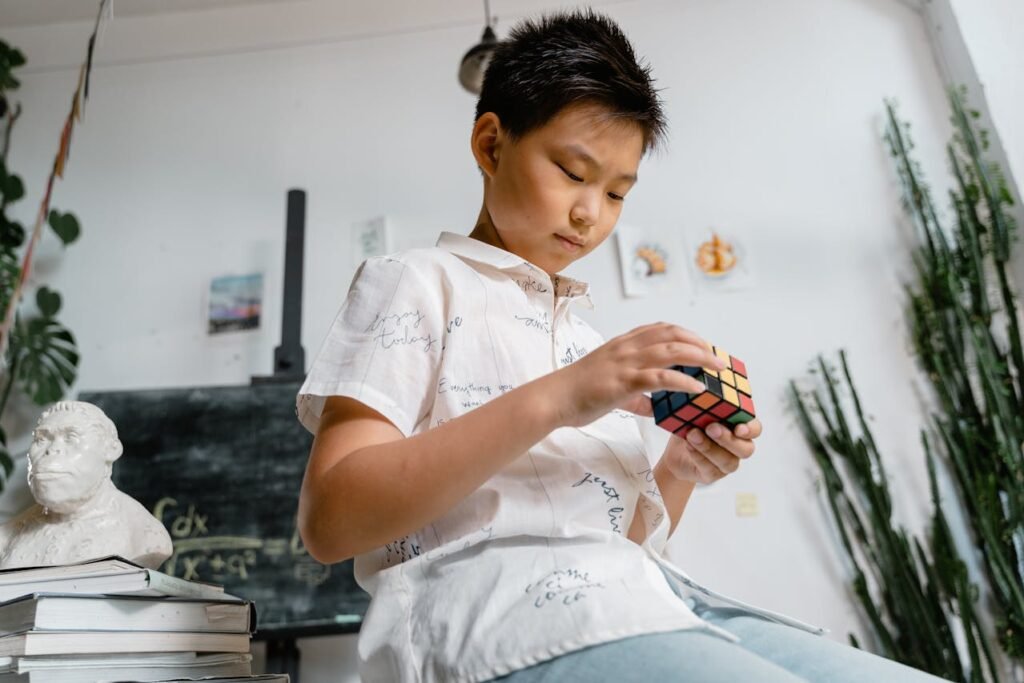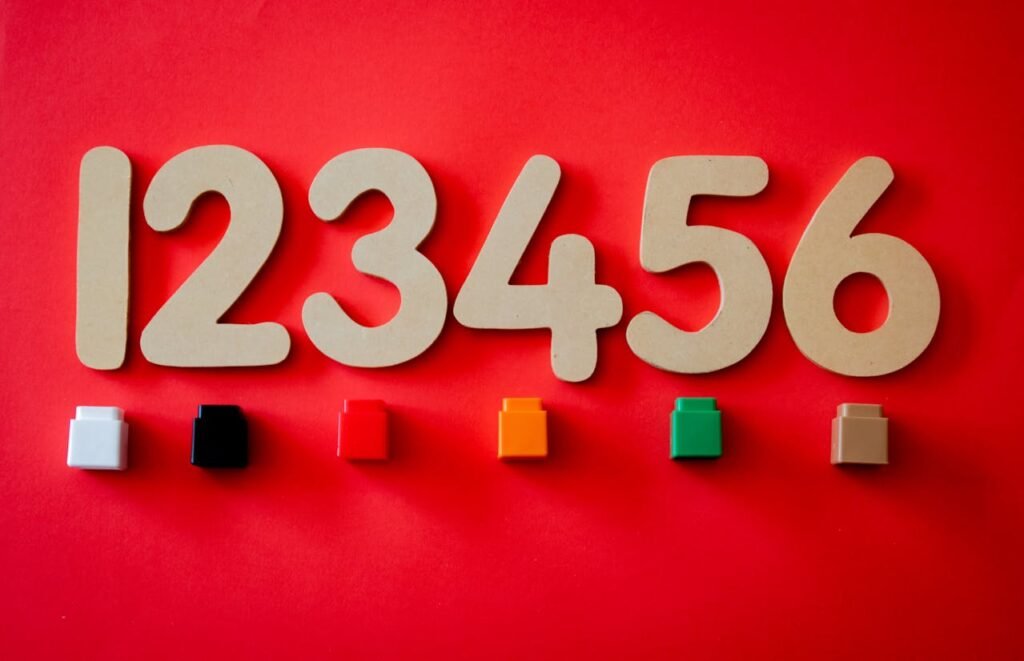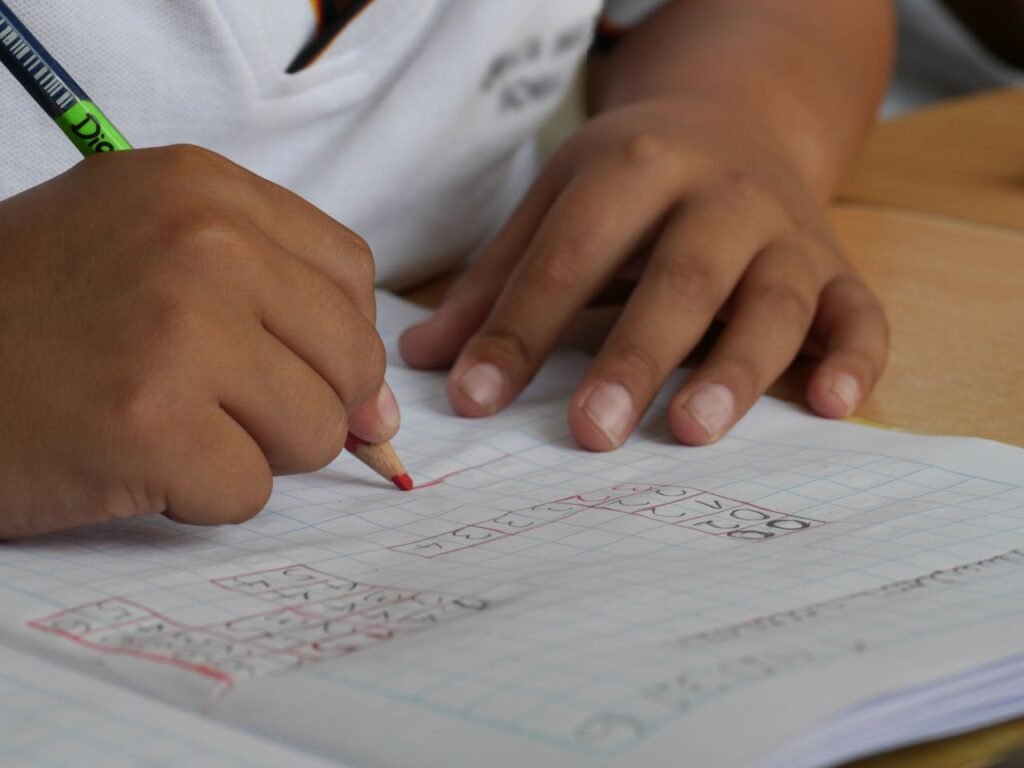If you’ve ever watched a child line up their toys in a certain order or tap a rhythm on the table, you’ve seen the magic of patterns in action. Patterns are everywhere—on the tiles in your kitchen, in the petals of a flower, even in the way we clap our hands.
In math, these patterns often appear as number sequences—numbers that follow a special rule. And here’s the fun part: once you know the rule, you can guess what comes next. It’s like being a detective who finds clues and solves puzzles.
The best thing about number patterns is that they make math feel alive. Instead of just adding or subtracting for no reason, kids discover a hidden order behind the numbers. They start to see math not as random, but as a language with its own rhythm and design.
What Are Number Patterns and Sequences?
A number pattern is a set of numbers that follow a specific, predictable rule. The exciting part is that once you figure out the rule, you can keep the pattern going forever—just like extending a song’s rhythm or continuing a row of bricks in a wall.
A sequence is simply this pattern written in a certain order. Every number in the sequence has its place, and the order matters.
1. How It Works
Imagine you are walking and leaving footprints in the sand. If each step you take is exactly the same length, anyone watching can guess where your next footprint will be, even before you take the step. That’s exactly how number patterns work—if you know the “step size” or the rule, you can guess the next number without seeing it yet.
Example:
2, 4, 6, 8, 10, …
The rule is simple: “Add 2 each time.”
- Start at 2 → add 2 → 4
- Add 2 again → 6
- Add 2 again → 8
- Add 2 again → 10
Next would be 12, then 14, then 16, and so on.
This is like having a math GPS—once you know the route, you can keep going in the right direction.
2. Different Kinds of Patterns
Number patterns can follow many different rules. Some are simple, some are tricky, and some even mix more than one rule at a time.
Addition patterns
You keep adding the same number.
Example: 5, 8, 11, 14, … (Rule: add 3)
Subtraction patterns
You keep subtracting the same number.
Example: 20, 15, 10, 5, … (Rule: subtract 5)
Multiplication patterns
You multiply by the same number each time.
Example: 1, 2, 4, 8, 16, … (Rule: multiply by 2)
Mixed patterns
You use more than one rule in turns.
Example: 1, 4, 3, 6, 5, 8, … (Rule: add 3, then subtract 1, repeat)
Mixed patterns are especially fun because they feel like puzzles—you have to look very carefully to spot the repeating steps.
3. Why They Matter
Number patterns aren’t just something fun to look at—they are powerful tools for building strong thinking skills.
When children work with patterns, they:
- Sharpen observation skills – They learn to notice small changes between numbers.
- Boost mental math – Predicting the next number means practicing addition, subtraction, multiplication, or division in their head.
- Learn to predict outcomes – Patterns teach kids that math isn’t random—there’s always a reason behind the numbers.
At Debsie, we use games, riddles, and even art activities to teach patterns. For example, kids might color tiles based on a number sequence, or create “secret codes” where each number is a letter. This way, they are learning math while also feeling like they are solving a fun mystery.
Why Kids Love Number Patterns

Children are naturally curious. They love to spot things that repeat—whether it’s clapping to a beat, stacking blocks in a certain way, or arranging their toys by size. Number patterns tap into this same instinct. They take something that could feel like plain math and turn it into a kind of treasure hunt.
1) Patterns Feel Like Solving a Puzzle
When kids see a number sequence, it’s like finding a trail of clues. Their brain switches into “detective mode,” trying to figure out the rule that connects each number to the next.
Example:
3, 6, 9, 12, …
They might notice: “Each number is 3 more than the last.” Once they figure it out, it’s like discovering the key to a secret code.
Why this excites them:
- There’s a sense of accomplishment when they “crack the rule.”
- They get instant feedback—if their next number follows the rule, they know they’re right.
2) They Can Predict the Future
Patterns give kids a way to predict what will happen next. This is powerful because predicting correctly makes them feel smart and in control.
Example:
If the pattern is 5, 10, 15, 20, … they already know 25 will come next, even before they write it down.
Why this excites them:
- It feels like having “math superpowers.”
- It’s satisfying to be right without guessing.
3) Patterns Show the Hidden Beauty of Math
Instead of seeing math as random problems, kids start to notice that numbers have a rhythm, just like music or dance.
Example:
In the sequence 2, 4, 8, 16, … the numbers double each time. On a chart, these jumps look like a beautiful curve.
Why this excites them:
- They begin to see that math is not just about getting an answer—it’s about finding order in chaos.
- This sense of “hidden beauty” keeps them curious.
4) Patterns Are Fun to Create
Once children understand how a pattern works, they love inventing their own. They might make tricky ones for friends or parents to solve, like:
2, 5, 10, 17, 26, … (Add 3, then add 5, then add 7, and so on.)
Why this excites them:
- They get to be the “teacher” or “puzzle master.”
- They enjoy challenging others with something they made.
Different Types of Number Patterns Kids Can Explore

Number patterns come in many shapes and forms. Some are straightforward, others are tricky, and each one teaches a different kind of thinking. By exploring them one by one, children not only improve their math skills but also learn to recognize order in everyday life.
1) Growing Patterns
What they are:
Growing patterns are sequences where the numbers keep getting bigger. The increase follows a rule that stays the same every time. The “growth” might happen slowly (adding a small number each time) or very quickly (multiplying each number).
Simple example – addition growth:
2, 4, 6, 8, 10, …
Rule: Add 2 every time.
Bigger example – multiplication growth:
1, 3, 9, 27, 81, …
Rule: Multiply by 3 every time.
Why they’re useful:
- They help children understand that adding the same number repeatedly is linked to multiplication.
- They give an early introduction to the idea of multiplication tables and repeated patterns in math.
- Multiplication growth patterns (like doubling) prepare kids for understanding how things grow rapidly—like populations, money in a bank, or even how bacteria multiply.
At Debsie: We often use “story” examples—like planting seeds that double in number each day—to make the pattern more visual and exciting.
2) Shrinking Patterns
What they are:
Shrinking patterns are the opposite of growing patterns. Here, numbers get smaller each time, either by subtracting a fixed amount or by dividing.
Simple example – subtraction shrink:
50, 45, 40, 35, 30, …
Rule: Subtract 5 every time.
Bigger example – division shrink:
64, 32, 16, 8, 4, 2, …
Rule: Divide by 2 every time.
Why they’re useful:
- They train kids to think in reverse, an important skill for subtraction and division.
- They help students understand how numbers reduce at different speeds (slowly with subtraction, quickly with division).
- Division patterns prepare children for fractions and decimals.
At Debsie: We turn shrinking patterns into “countdown games” where children race to see how quickly they can reach zero or one by following the rule.
3) Alternating Patterns
What they are:
Alternating patterns use more than one rule. The rules switch back and forth in a repeating cycle. This creates a “zigzag” effect when you look at the numbers.
Example:
2, 6, 5, 9, 8, 12, 11, …
Rule: Add 4, then subtract 1, repeat.
Why they’re useful:
- They teach children to stay alert—no assuming that every step is the same.
- They build focus and pattern recognition skills.
- They are a natural bridge to more complex sequences in higher grades.
At Debsie: We give kids “trick patterns” that look random until they realize there are two rules hiding inside. This makes the moment of discovery very satisfying.
4) Skip Counting Patterns
What they are:
Skip counting is counting forward or backward by a set number each time. This is one of the simplest patterns but also one of the most important.
Example:
Skip counting by 7: 7, 14, 21, 28, 35, …
Why they’re useful:
- They build multiplication table fluency.
- They strengthen quick mental addition skills.
- They prepare children for division because they can see which numbers are “multiples” of another number.
At Debsie: We combine skip counting with clapping, jumping, or even drumming to help younger kids remember the rhythm of the numbers.
5) Shape or Position Patterns
What they are:
These are patterns where the numbers are connected to a shape or arrangement, not just to each other by math operations. They combine numbers with visual thinking.
Example:
Triangular numbers: 1, 3, 6, 10, 15, …
Here, each number shows how many dots are needed to form a perfect triangle.
- 1 dot → small triangle
- 3 dots → bigger triangle
- 6 dots → even bigger triangle
Why they’re useful:
- They help visual learners understand numbers in a spatial way.
- They connect math to geometry and art.
- They make abstract numbers more concrete by showing them as real objects.
At Debsie: We often use LEGO bricks, beads, or drawing apps so kids can physically build these patterns and see them grow.
How to Help Kids Spot Patterns Easily

Spotting patterns is a skill, and like any skill, it gets better with practice. Some children notice patterns quickly, while others need a little help to “see” them. The good news is, there are simple ways to train the brain to catch these hidden rules.
1) Start with Small Number Sets
If the numbers are too big or the sequence is too long, kids can feel overwhelmed. Begin with short, simple patterns of 4–5 numbers.
Example:
2, 4, 6, 8
Ask: “What’s happening from one number to the next?”
Why this works:
Small sets let kids focus on the change, not on remembering long lists. Once they succeed with short patterns, you can extend them step by step.
At Debsie: Teachers often reveal patterns in “stages,” adding one number at a time so students can guess the rule without stress.
2) Ask the Right Questions
Instead of telling kids the rule, guide them with questions:
- “Is the number getting bigger or smaller?”
- “Are we adding, subtracting, multiplying, or dividing?”
- “Is the change always the same?”
- “Could there be two rules alternating?”
Why this works:
Good questions make kids think instead of guess. It also teaches them the thought process they can use independently later.
3) Use Real-Life Examples
Numbers feel less intimidating when they’re connected to something children already understand.
Examples:
- Counting the number of wheels on parked bicycles (add 2 each time).
- Watching the price of an item go down in a sale (subtracting a fixed amount).
- Tracking a ball’s bounce height (shrinking pattern).
Why this works:
Real-world connections help kids realize that patterns aren’t “just in math books” — they’re everywhere.
4) Encourage “Guess and Check”
Once a child thinks they’ve found the rule, let them test it by predicting the next few numbers and checking if it works.
Example:
Pattern: 5, 10, 15, 20
Child’s guess: “Add 5.”
Check: Next number should be 25 → yes, it works.
Why this works:
It builds confidence and reinforces the habit of checking answers.
5) Let Kids Make Their Own Patterns
After practicing spotting rules, let children create their own number sequences for you—or other students—to solve.
Example:
“Add 4, then subtract 2” → 2, 6, 4, 8, 6, 10, …
Why this works:
When kids make a pattern, they have to think backwards about how rules work. This deepens understanding and makes learning fun.
Fun Pattern Challenges to Try at Home

Patterns are more fun when they feel like games instead of schoolwork. At home, you can turn pattern spotting into short challenges that make kids feel clever and accomplished. Here are some ideas you can start today.
1) The “What’s Next?” Game
How to play:
- Write down 4–5 numbers from a pattern.
- Ask your child to figure out the rule and write the next 3 numbers.
Example:
3, 6, 9, 12, …
Rule: Add 3.
Next: 15, 18, 21.
Why kids love it:
It feels like a puzzle with a clear goal. They get instant feedback when they check if their answer follows the rule.
Tip: Start easy, then slowly make the rule trickier—like switching to alternating rules.
2) Pattern Detective Hunt
How to play:
- Pick something in the house or outside (tiles, books, flowers, colors in a row).
- Ask your child to describe the pattern they see.
Example:
- Tiles: Square, square, diamond, square, square, diamond.
- Books: Tall, short, tall, short, tall, short.
Why kids love it:
It turns everyday objects into a discovery game. Plus, it shows that patterns aren’t just numbers—they can be shapes, colors, or positions.
3) The Skip Counting Challenge
How to play:
- Choose a skip counting number (like 4 or 6).
- Take turns saying the numbers out loud in order—each player says the next number quickly.
Example:
Player 1: 4
Player 2: 8
Player 1: 12
Player 2: 16
Why kids love it:
It’s fast-paced, it feels like a race, and it secretly builds multiplication fluency.
At Debsie: We turn this into a “jump and count” activity for younger kids—each jump matches a number in the sequence.
4) Make Your Own “Secret Code”
How to play:
- Assign each letter of the alphabet a number in a pattern.
- Write short messages that follow the pattern.
Example:
If the pattern is “add 2,” then A=1, C=3, E=5, G=7, and so on.
The word “ACE” becomes 1–3–5.
Why kids love it:
It combines math with mystery, and they get to be the puzzle-maker as well as the solver.
5) Pattern Relay
How to play:
- One person writes the first 3 numbers and the rule.
- The other continues the pattern for the next 5 numbers.
- Switch roles.
Example:
Rule: Multiply by 2. Start: 1, 2, 4 → next: 8, 16, 32, 64, 128.
Why kids love it:
They get to take turns being the “rule setter” and the solver, which keeps them engaged and competitive in a friendly way.
How Debsie Uses Patterns to Boost Learning in Every Age Group

One of the reasons Debsie students connect so deeply with number patterns is that we don’t teach them the same way to everyone. A 6-year-old exploring patterns for the first time needs a very different approach from a 14-year-old preparing for advanced math. Our partner teachers adjust the lessons so they’re fun, challenging, and age-appropriate—while always building the same core skills of spotting, predicting, and creating patterns.
1) Early Years (Ages 5–7)
How we teach:
At this age, learning patterns is almost entirely hands-on and visual. We use colorful counters, building blocks, beads, and even clapping and jumping games. Children physically “build” the patterns and say them out loud.
Example activity:
- Red bead, blue bead, red bead, blue bead → “What comes next?”
- Counting aloud: 2, 4, 6, 8 → children jump every time they say the next number.
Why it works:
Young children learn best through movement and play. By using objects they can see and touch, patterns become something they experience, not just memorize.
2) Middle Primary (Ages 8–10)
How we teach:
We start introducing number-only patterns alongside visual ones. This is when addition, subtraction, and multiplication sequences take center stage. Kids also begin solving short “missing number” puzzles where they must fill in gaps in a sequence.
Example activity:
- Pattern: 5, __, 15, 20 → “What goes in the blank?” (Rule: +5)
- Alternating pattern: +2, –1 → 3, 5, 4, 6, 5, 7…
Why it works:
At this stage, kids can handle basic abstract thinking but still benefit from step-by-step guidance. We keep the rules clear and predictable while slowly increasing complexity.
3) Upper Primary (Ages 11–12)
How we teach:
We introduce more complex rules, including alternating operations, multiplication/division combinations, and simple algebraic patterns. Students also begin exploring patterns in shapes (like triangular and square numbers) and patterns in times tables.
Example activity:
- Pattern: Multiply by 2, then subtract 1 → 2, 3, 5, 9, 17…
- Shape pattern: How many dots to make a triangle with 6 rows?
Why it works:
Older primary students are ready for a challenge, and pattern puzzles prepare them for algebra by teaching them to identify and apply multi-step rules.
4) Lower Secondary (Ages 13–15)
How we teach:
This is where patterns directly connect to algebra, sequences, and functions. We work with arithmetic sequences (adding/subtracting the same number) and geometric sequences (multiplying/dividing by the same number). Students also learn to write the “nth term” formula for a sequence.
Example activity:
- Arithmetic sequence: 4, 7, 10, 13 → nth term = 3n + 1
- Geometric sequence: 3, 6, 12, 24 → nth term = 3 × 2^(n–1)
Why it works:
By linking patterns to formulas, students see the bridge between playful pattern spotting and formal math concepts they’ll need for exams.
5) Upper Secondary (Ages 16–18)
How we teach:
At this level, patterns connect to advanced topics—series, summations, and sequences in real-world contexts like finance and science. Lessons involve more independent problem-solving, modeling, and proof-based thinking.
Example activity:
- Predicting savings growth using a geometric sequence formula.
- Exploring Fibonacci numbers in nature and art.
Why it works:
Older students see how patterns power real-world systems, from computer algorithms to population studies. This makes learning relevant and inspiring.
The Life Skills Kids Gain from Learning Patterns
When children work with number patterns, they’re not just practicing math—they’re training their brains to think in ways that help them in almost every area of life. Patterns build habits of mind that stay with them long after the math lesson is over.
1) Sharper Observation Skills
Spotting a pattern means paying close attention to details. Kids learn to notice small changes from one number to the next, just like a detective looking for clues.
Why it matters:
This skill translates into everyday life—spotting trends in sports scores, noticing changes in a friend’s mood, or even catching mistakes in homework before turning it in.
At Debsie: We train this skill by giving “hidden rule” challenges, where students must spot the smallest change between steps to uncover the pattern.
2) Logical and Sequential Thinking
Patterns have rules, and rules have to be followed step-by-step. This teaches kids to think in a logical order: first step, second step, third step.
Why it matters:
Logical thinking is essential for science experiments, writing essays, cooking recipes, and even solving real-life problems like planning a trip.
At Debsie: We connect patterns to real-world sequences—like following instructions to build a LEGO model—so students understand that order matters.
3) Problem-Solving Confidence
When kids successfully figure out a pattern, they get a confidence boost. They realize, “I can work this out on my own.”
Why it matters:
Confidence in problem-solving means they’ll try harder questions instead of giving up, both in math and in life.
At Debsie: We make sure every child gets early wins—starting with easy patterns and gradually building to tougher ones—so they feel capable from the start.
4) Prediction and Planning Skills
Patterns allow children to predict what comes next. This isn’t just a math skill—it’s a life skill.
Why it matters:
In real life, being able to predict outcomes helps in budgeting money, planning study schedules, or estimating how long a project will take.
At Debsie: We encourage students to make predictions in all kinds of lessons—not just math—so this skill becomes second nature.
5) Creativity and Imagination
Once kids understand how patterns work, they love making their own. They might invent tricky rules for friends to solve, or even design art using number sequences.
Why it matters:
Creativity in math helps children see themselves as active learners, not just people who “follow the book.” This mindset is valuable in innovation, design, and problem-solving careers.
At Debsie: We have “Pattern Creation Days” where students build their own number sequences and swap them with classmates for solving.
Conclusion — Turning Number Patterns into a Lifetime Advantage
Number patterns are more than a math topic—they’re a way of thinking. They teach kids to spot clues, follow rules, make predictions, and create their own solutions. These are not just school skills; they’re life skills.
When a child learns to see patterns, they stop viewing math as random problems on a page. Instead, they start seeing order, rhythm, and even beauty in numbers. They gain the confidence to face harder challenges because they’ve trained their brain to break problems down into clear, manageable steps.
At Debsie, we’ve seen this transformation in students of every age. Our partner teachers know exactly how to present patterns in ways that spark curiosity, build skill, and keep learning fun. Whether it’s through games, puzzles, art, or advanced problem-solving, we make sure every child can not only spot patterns but also use them in school and in real life.
📌 Here’s the truth: once your child can master patterns, they have a secret weapon for every other area of math—and beyond.
👉 Give your child that advantage today.
Book a free trial class at https://debsie.com/courses/ and watch them discover the hidden magic in numbers.
Read next:



